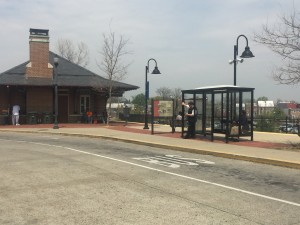By Ashley Barnes
Frederick County executives proposed additional operating funding that will allow Transit buses to expand shuttles to run from two trips per day to four trips per day.
Currently Frederick holds nine connector routes that operate in urban areas around the county. These transit shuttles include commuter, two Meet-the-MARC and paratransit shuttles that service the elderly and handicapped.

Service Planner for Transit services Carrie Watters stated that public transportation is a worthwhile expenditure that provide a lot of services for a relatively insignificant cost. Watters believes Fredericks Transit services need to be greatly expanded to serve a larger service area and provide more convenient services.
Under the Frederick transit county development plan, transit needs have been identified based on a 2000 Census data report. Proposes have been made to link commuter modes, add new shuttles through Brunswick, create group trips, and re-evaluate the needs of elderly and disabled citizens in order to increase productivity, according to TDP.
As of 2010, Frederick county’s population had roughly 233,390 people, according to the Frederick County Transit Plan summary. This number represents a steady growth from 1990 to 2000. Maryland Department of Planning estimates that in the next 30 years, Frederick will grow about 44 percent, which will double the rate of the state overall.
To prepare for the growing population, Transit have focused their service needs based on population density. According to Frederick County Development plan, an area with a density of 2,000 people per square mile will generally be able to sustain frequent daily Transit services.
Watters said that the primary way Transit measures service effectiveness is through the number of riders. Although there are many factors that affect ridership, she assumes that when ridership is high, then Transit services are needed and useful.
For many years ridership with Transit services have increased significantly. However, In the past couple of years Transit services have seen decreases, Watters says. The former Board of County Commissioners has required Transit to increase bus fares from $1.10 to $1.25 and then to $1.50 in the last three years.
“This has had a significant impact on our ridership because the population we currently serve is primarily transit-dependent and tend to be low-income, fare increases are particularly difficult for them to absorb,” Watters stated.
In contrary, Dynise Bolden, senior at Hood College has ridden transit buses in Frederick for the last four years. She believes that Frederick doesn’t have enough connector routes in the area.
“Freshman year I was craving chipotle, so I took the bus there but still had to walk a mile distance to actually get there,” Bolden said “There just aren’t enough bus stops spread out, the busses do take you certain places, but not very far, they need to improve by extending more routes.”
Additionally, land usage and new developments continue to influence the demand for additional Transit services. According to the Frederick County Development plan, Urbana is a key area of significant growth in the Frederick County. Transit officials stated that they hoped to add additional connectors that would service from Montgomery County to downtown Frederick.
According to Fredericks 2013 Transit Summary survey, 97.2 percent of riders reported to have had a positive Transit services. These customers were frequent users of transit and rode Monday through Friday. Positive feedback ranged from convenient bus service hours to on-time performance and vehicle cleanliness.
Comments were left for Transit services to make future improvements. Riders requested for Sunday services, expanding service areas and increasing bus stop locations.
Tiffany Kendall, Community Relations Manager markets Transit services daily. Kendall markets campaigns with the Frederick New post, WFRE, and other print media such as the Frederick County Tourism Guide.
“Since we have three main focuses on Transit- regular connector, shuttle service and paratransit service, employer outreach can vary,” Kendall states, “At Earth day we pushed all three services since Transit is an alternative to driving alone in your car.”
Frederick County Transit development plan proposed projects for the 2016-2017 year. These plans included:
- Implementing route adjustments on the #10, #20, #60/61, and #65 to address on-time performance issues and increase service quality.
- Collaborating with City and County planning staff to increase transportation and land use coordination.
- Transitioning all of the Connector routes from deviation to complementary ADA paratransit, in order to reduce delays and aid on-time performance.
- Working with MTA, the City of Frederick, and Greyhound to extend Transit Center access and hours of operation.
- Extending TransIT-plus service hours from 7 a.m. to 6 p.m.
In Watters opinion, she believes that local Frederick routes should be operating on a 15 minute frequency, which currently runs on 30 and 60 minute frequencies. Watters believes that Frederick should provide more adequate service to outlying communities.
Frederick County Executive Jan Gardner responded to Frederick citizens. Gardner states that this new proposed state budget prioritizes education, safe communities, and valuing the citizens.
“Open, transparent, and participatory government is fundamental to good government. That’s why my budget is a result of a great deal of time listening to citizens and leaders in the county departments and divisions. I am thankful for everyone’s input and I believe this budget ensures a very bright future for Frederick County” she states.